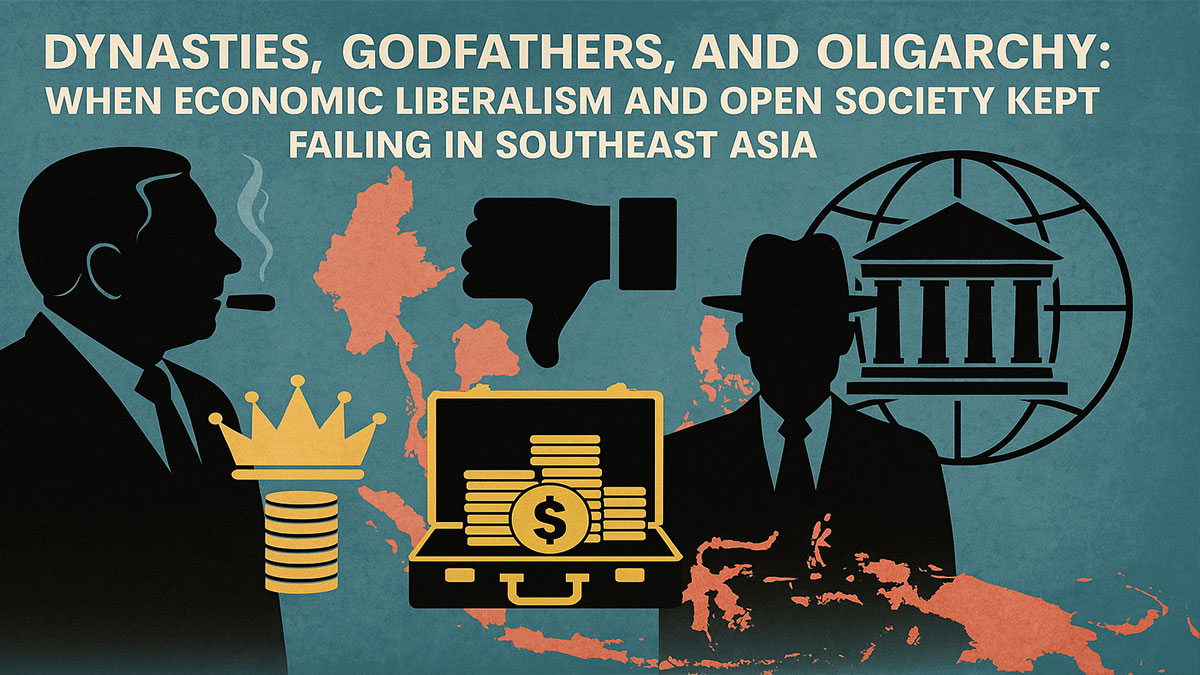
The intersection between political regimes and economic structures has long been a subject of interest for economists and political theorists alike.
From the perspectives of classical liberalism and neoliberalism, particularly those espoused by the Chicago School of Economics, economic liberalization should theoretically lead to open and competitive markets, reducing the entrenchment of oligarchic structures.
However, reality demonstrates that dynasties, godfathers, and oligarchies persist, influencing political and economic decision-making, as captured in the works of Joe Studwell (2007), Thomas Piketty (2014), Robert Reich (2020), and Emmanuel Saez (2019).
This essay explores how the theoretical frameworks of Milton Friedman, Friedrich Hayek, and Karl Polanyi, alongside critical analyses from Susan George, Nazrin Shah, Rajah Rasiah, and Kamal Salih, reveal why economic liberalism and the ideal of an open society have failed to dismantle entrenched elite structures in Southeast Asia.
Milton Friedman (1962) and Friedrich Hayek (1944) argue that free markets, when left to their own devices, self-regulate and drive economic efficiency.
Friedman, in Capitalism and Freedom, posits that limited government intervention allows for market forces to correct inefficiencies. Similarly, Hayek’s The Road to Serfdom warns against centralized control, advocating for spontaneous market order.
However, despite these theoretical claims, historical and contemporary case studies demonstrate that economic liberalization has often led to the consolidation of wealth within powerful families rather than market-driven meritocracy (Piketty, 2014).
Karl Polanyi (1944), in The Great Transformation, critiques the market’s self-regulating capacity by demonstrating that unregulated capitalism ultimately leads to monopolistic behavior, increasing inequality, and entrenching dynastic wealth.
Polanyi's argument highlights that markets are not self-correcting but instead require social and political interventions to ensure fair distribution.
His critique aligns with Susan George’s (A Fate Worse than Debt, 1988) assertion that global economic structures, rather than fostering democracy, often reinforce the dominance of political and economic elites.
Joe Studwell (2007), in Asian Godfathers, exposes the role of business elites in Southeast Asia, where economic liberalization has not diluted oligarchic control but instead reinforced it.
Through extensive case studies, Studwell illustrates how deregulation and privatization have allowed well-connected families to amass wealth, monopolizing entire industries.
Similarly, Nazrin Shah (2017) explores how state-led capitalism in Malaysia has facilitated the concentration of wealth among political elites, reducing economic opportunities for the broader population.
Rajah Rasiah and Kamal Salih have contributed significantly to understanding how Southeast Asian economies have evolved under conditions of political patronage.
Rasiah (2011) critiques the uneven industrial policies in the region, emphasizing that despite neoliberal aspirations, economic growth has often been driven by elite-controlled networks.
Kamal Salih (1999) further demonstrates that state policies in Malaysia, Indonesia, and the Philippines have primarily benefited entrenched elites rather than fostering inclusive development.
Thomas Piketty’s Capital in the Twenty-First Century (2014) empirically substantiates these claims by showing that wealth concentration is a structural feature of capitalism, where the rate of return on capital exceeds economic growth.
This means that dynastic families and oligarchs continue to expand their wealth faster than the general population can accumulate economic gains. Robert Reich (2020) further critiques the neoliberal model by arguing that deregulated markets enable corporations and oligarchs to capture political systems, reinforcing inequality.
Emmanuel Saez (2019) and Thomas Piketty argue that when wealth becomes too concentrated, democracy itself is at risk. Political influence becomes a commodity accessible only to those with vast financial resources, enabling policy manipulation in favor of the elite.
This process, often referred to as ‘regulatory capture,’ is evident in cases such as the 1997 Asian Financial Crisis, where oligarchic elites in Indonesia, Malaysia, and Thailand were bailed out, while the broader population bore the economic consequences (Nazrin Shah, 2017).
Susan George (1988) provides a parallel critique of global financial institutions such as the International Monetary Fund (IMF) and the World Bank, arguing that their policies disproportionately favor entrenched elites in developing nations rather than promoting inclusive economic growth. Her analysis underscores the failures of economic liberalism in preventing wealth concentration and political entrenchment.
While classical liberal economists argue that open markets create a level playing field, empirical evidence from Studwell, Piketty, Reich, Saez, George, Nazrin Shah, Rajah Rasiah, and Kamal Salih suggests otherwise.
The failure of economic liberalism and the open society ideal stems from the inherent ability of powerful families and oligarchs to manipulate market mechanisms for their benefit.
The works of Polanyi and George demonstrate that unregulated markets facilitate elite capture rather than meritocratic competition.
Thus, economic liberalism alone cannot serve as an antidote to oligarchic entrenchment. Instead, targeted regulatory frameworks and structural reforms are necessary to prevent collusion between political and economic elites, ensuring a more equitable distribution of resources.
References
Friedman, M. (1962). Capitalism and freedom. University of Chicago Press.
George, S. (1988). A fate worse than debt. Grove Press.
Hayek, F. A. (1944). The road to serfdom. University of Chicago Press.
Nazrin Shah, M. (2017). Malaysia's political economy: State capitalism and the patronage trap. Cambridge University Press.
Piketty, T. (2014). Capital in the twenty-first century. Harvard University Press.
Polanyi, K. (1944). The great transformation. Farrar & Rinehart.
Rasiah, R. (2011). Industrialization and development in Southeast Asia: Myths, realities, and prospects. Routledge.
Reich, R. (2020). The system: Who rigged it, how we fix it. Knopf.
Saez, E. (2019). The triumph of injustice: How the rich dodge taxes and how to make them pay. W. W. Norton & Company.
Salih, K. (1999). The political economy of development in Southeast Asia: A critical perspective. Edward Elgar Publishing.
Studwell, J. (2007). Asian godfathers: Money and power in Hong Kong and Southeast Asia. Atlantic Monthly Press.
Last Update: 06/04/2025